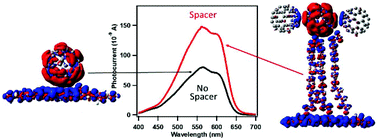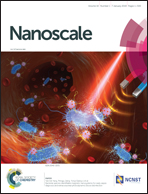The crucial role of a spacer material on the efficiency of charge transfer processes in organic donor–acceptor junction solar cells†
Abstract
Organic photovoltaic donor–acceptor junction devices composed of π-conjugated polymer electron donors (D) and fullerene electron acceptors (A) show greatly increased performance when a spacer material is inserted between the two layers (W. Y. Nie, G. Gupta, B. K. Crone, F. L. Liu, D. L. Smith, P. P. Ruden, C. Y. Kuo, H. Tsai, H. L. Wang, H. Li, S. Tretiak and A. D. Mohite, Adv. Sci., 2015, 2, 1500024.). For instance, experimental results reveal significant improvement of photocurrent when a terthiophene oligomer derivative is inserted in between π-conjugated poly(3-hexylthiophene-2,5-diyl) (P3HT) donor and C60 acceptor. These results indicate favorable charge separation dynamics, which is addressed by our present joint theoretical/experimental study establishing the beneficial alignment of electronic levels due to the specific morphology of the material. Namely, based on the experimental data we have constructed extended structural interface models containing C60 fullerenes and P3HT separated by aligned oligomer chains. Our time-dependent density functional theory (TD-DFT) calculations based on a long-range corrected functional, allowed us to address the energetics of essential electronic states and analyze them in terms of charge transfer (CT) character. Specifically, the simulations reveal the electronic spectra composed of a ladder of excited states evolving excitation toward spatial charge separation: an initial excitonic excitation at P3HT decomposes into charges by sequentially relaxing through bands of C60-centric, oligomer → C60 and P3HT → C60 CT states. Our modeling exposes a critical role of dielectric environment effects and electronic couplings in the self-assembled spacer oligomer layer on the energetics of critical CT states leading to a reduced back-electron transfer, preventing recombination losses, and thus rationalizes physical processes underpinning experimental observations.



 Please wait while we load your content...
Please wait while we load your content...